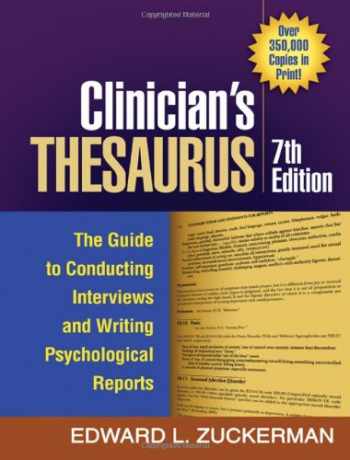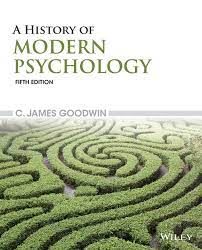Test bank for Clinicians Thesaurus 7th Edition by Edward L. Zuckerman
Original price was: $55.00.$50.00Current price is: $50.00.
Digital item No Waiting Time Instant Download
By: Edward L. Zuckerman
ISBN-10: 1606238744
ISBN-13: 9781606238745
Language: English
Authors: Edward L. Zuckerman
Publisher: The Guilford Press
Description
Test bank for Clinicians Thesaurus 7th Edition by Edward L. Zuckerman
Table Of Contents
Acknowledgments and an Invitation xviiGetting Oriented to the
Clinician’s Thesaurus
1
What Is the
Clinician’s Thesaurus
and What Does It Do?, 1How This Book Is Organized, 2Understanding the Style and Format of the Chapters, 3 A Functional Guide to Report Construction, 7 Further Guidelines and Advice on Report Writing, 13Some Ways to Use the
Clinician’s Thesaurus
, 16 A Cautionary Note and Disclaimer, 17
PART I. Conducting a Mental Health Evaluation
1. Beginning and Ending the Interview 21
1.1. Structuring the Interview, 21 1.2. Introducing Yourself and Noting Possible Communication Difficulties, 21 1.3. Assessing the Client’s Understanding of the Interview Situation, 22 1.4. Obtaining Informed Consent, 23 1.5. Other Points for All Interviews, 23 1.6. Eliciting the Chief Concern/Complaint/Issue, 24 1.7. Eliciting the Client’s Understanding of the Problem, 24 1.8. Dimensionalizing the Concern/Problem, 24 1.9. Ending the Interview, 25
2. Mental Status Evaluation Questions/Tasks 26
2.1. Introduction to the Mental Status Questions, 26 2.2. Background Information Related to Mental Status, 27 2.3. Rancho Los Amigos Cognitive Scale, 27 2.4. Glasgow Coma Scale, 28 2.5. Orientation, 28 2.6. Attention,
30
2.7. Concentration,
30
2.8. Comprehension of Language, 31 2.9. Eye–Hand Coordination/Perceptual–Motor Integration/ Dyspraxia/ Constructional Ability, 312.10. Memory, 322.11. Fund of Information, 342.12. Opposites, 352.13. Differences, 362.14. Similarities/Analogies, 362.15. Absurdities, 362.16. Calculation Abilities, 37 2.17. Abstract Reasoning/Proverbs, 38
viii
Contents
2.18. Paired Proverbs, 382.19. Practical Reasoning, 392.20. Social Judgment, 392.21. Decision Making, 402.22. Self-Image, 402.23. Insight into Disorder, 402.24. Strengths and Coping, 412.25. Mental Status Evaluation Checklist, 41
3. Questions about Signs, Symptoms, and Other Behavior Patterns 44
3.1. Introduction to the Questions about Signs, Symptoms, andBehavior Patterns, 44 3.2. Abuse (Nonsexual)/Neglect of Spouse/Elder, 45 3.3. Abuse (Nonsexual)/Neglect of Child, 46 3.4. Abuse (Sexual) of Child or Adult, 46 3.5. Affect/Mood, 47 3.6. Anxiety, 48 3.7. Body Dysmorphic Disorder, 48 3.8. Compliance–Noncompliance with Treatment, 48 3.9. Compulsions, 493.10. Delusions, 503.11. Depression, 513.12. Dissociative Experiences, 533.13. Eating Disorders, 543.14. Gay and Lesbian Identity Formation, 563.15. Hallucinations, 563.16. Illusions, 583.17. Impulse Control, 583.18. Mania, 583.19. Obsessions, 593.20. Organicity/Cognitive Disorders, 603.21. Pain, Chronic, 603.22. Paranoia, 613.23. Phobias, 623.24. Self-Injury, 623.25. Sexual History, 633.26. Sexual Identity/Transgender Issues, 653.27. Sleep, 663.28. Substance Abuse: Drugs and Alcohol, 67 3.29. Substance Use: Tobacco and Caffeine, 753.30. Suicide and Self-Destructive Behavior, 763.31. Violence, 78
PART II. Standard Terms and Statements for WordingPsychological Reports
A. Introducing the Report
4. Beginning the Report: Preliminary Information 83
4.1. Heading and Dates for the Report, 834.2. Sources of Information for the Report, 834.3. Identifying Information about the Client, 844.4. Self-Sufficiency in Appearing for Examination, 854.5. Consent Statements, 864.6. Reliability/Validity Statements, 87 4.7. Confidentiality Notices, 894.8. Ethical Considerations in Report Writing, 91
Contents
ix
5. Referral Reasons 92
5.1. Statement of Referral Reason, 925.2. Common Referral Reasons for Children at Home, 935.3. Common Referral Reasons for Children at School, 935.4. Common Referral Reasons for Children at Both Home and School, 95
6. Background Information and History 97
6.1. History/Course of the Present/Chief Complaint/Concern/Problem/Illness, 97 6.2. Medical History and Other Findings, 986.3. Personal, Family, and Social Histories, and Current Social Situation, 996.4. Adjustment History, 1026.5. Social History for a Disability Examination, 1036.6. Family Genogram/Family Tree/Pedigree, 104
B. The Person in the Evaluation
7. Behavioral Observations 107
7.1. Appearance, 107 7.2. Clothing/Attire, 110 7.3. Movement/Activity, 111 7.4. Speech Behavior, 114 7.5. Other Behavioral Observations, 117
8. Responses to Aspects of the Examination 118
8.1. Reaction to the Context of the Evaluation, 118 8.2. Attention/Concentration/Effort, 120 8.3. Response to the Methods of Evaluation/Tests/Questions, 121 8.4. Persistence/Motivation, 122 8.5. Relationship with the Examiner, 123 8.6. Response to Success/Failure/Feedback, 125
9. Presentation of Self 127
9.1. Dependency–Surgency, 127 9.2. Presence/Style,
127
9.3. Self-Image/Self-Esteem, 128 9.4. Social Sophistication/Manners, 128 9.5. Warmth–Coldness, 129 9.6. Other Aspects of Self-Presentation, 129
10. Emotional/Affective Symptoms and Disorders 132
10.1. General Aspects of Mood and Affects, 13210.2. Anger, 13310.3. Anxiety/Fear, 13410.4. Bipolar I Disorder, 13610.5. Bipolar II Disorder, 13610.6. Cyclothymia, 137 10.7. Depression, 137 10.8. Guilt/Shame, 14210.9. Mania, 14310.10. Panic, 14410.11. Seasonal Affective Disorder, 14410.12. Sexuality, 14510.13. Other Affects/Emotional Reactions, 145
x
Contents
11. Cognition and Mental Status 146
11.1. No Pathological Findings: Summary Statements, 146 11.2. Arithmetic, 147 11.3. Attention, 147 11.4. Concentration/Task Persistence, 147 11.5. Consciousness Levels, 148 11.6. Decision Making, 148 11.7. Dementia, 149 11.8. Information, 149 11.9. Insight, 15011.10. Intelligence, Development, and Cognition: Assessment, 15111.11. Intelligence Scores: Classifications, 15211.12. Memory, 15311.13. Moral/Social Judgment and Knowledge, 15611.14. Motivation for Change: Summary Statements, 157 11.15. Orientation, 157 11.16. Reality Testing, 157 11.17. Reasoning/Abstract Thinking/Concept Formation, 15811.18. Social Maturity, 15911.19. Stream of Thought, 15911.20. Test Judgment: Summary Statements, 16211.21. Other Summary Statements for Mental Status, 162
12. Abnormal Signs, Symptoms, and Syndromes 163
12.1. Abuse, 163 12.2. AIDS Dementia Complex, 164 12.3. Attention-Deficit/Hyperactivity Disorder, 164 12.4. Autism Spectrum Disorders, 168 12.5. Battered-Woman Syndrome, 169 12.6. Body Dysmorphic Disorder, 170 12.7. Chronic Fatigue Syndrome, 171 12.8. Compulsions, 171 12.9. Conduct Disorder, 17212.10. Delusions, 17312.11. Denial, 17412.12. Depersonalization and Derealization, 17512.13. Dual Diagnoses, 17512.14. Eating Disorders, 17512.15. Fetal Alcohol Syndrome, 17812.16. Gambling, 17812.17. Hallucinations, 17912.18. Illusions, 18012.19. Impulse-Control Disorders, 18012.20. Malingering, 18212.21. Obsessions, 18312.22. Oppositional Defiant Disorder, 18412.23. Pain Disorder/Chronic Pain Syndrome, 18412.24. Paranoia, 18512.25. Phobias, 18512.26. Postconcussive Syndrome, 18612.27. Posttraumatic Stress Disorder, 18612.28. Premenstrual Dysphoric Disorder, 187 12.29. Rape Trauma Syndrome, 18912.30. Reactive Attachment Disorder, 19012.31. Schizophrenia, 19112.32. School Refusal/Avoidance/“Phobia,” 19212.33. Self-Injurious Behavior, 19312.34. Sexual Abuse, Child, 193
Contents
xi
12.35. Sexual Impulsivity/“Addiction”/“Compulsion,” 19412.36. Side Effects of Psychotropic Medications/Adverse Drug Reactions, 19512.37. Sleep Disturbances, 19612.38. Stalking, 19812.39. Substance Use, Abuse, and Dependence, 19812.40. Suicide, 20212.41. Violent Behaviors, 207
13. Personality Patterns 209
13.1. Models of Personality Diagnosis, 209 13.2. Assessment Methods, 211 13.3. Cognitive or Thinking Styles, 212 13.4. A and B Personality Types, 212 13.5. “Addictive” Personality, 214 13.6. Aggressive Personality, 214 13.7. Antisocial Personality, 214 13.8. Authoritarian Personality, 216 13.9. Avoidant Personality, 217 13.10. Borderline Personality, 21813.11. Codependent Personality, 21913.12. Compulsive Personality, 22113.13. Dependent Personality, 22213.14. Dissociative Identity Disorder, 22413.15. Histrionic Personality, 22513.16. Hypochondriacal Personality, 22613.17. Narcissistic Personality, 227 13.18. “Nervous” Personality, 22813.19. Normal/Healthy Personality, 22913.20. Obsessive Personality, 23013.21. Paranoid Personality, 23113.22. Passive– Aggressive Personality, 23213.23. Sadistic Personality, 23313.24. Schizoid Personality, 23413.25. Schizotypal Personality, 23513.26. Self-Defeating Personality, 235
C. The Person in the Environment
14. Activities of Daily Living 239
14.1. Assessment, 239 14.2. Assistance Level Required/Degree of Independence, 239 14.3. Child Care, 240 14.4. Chores/House Care/Domestic Skills, 240 14.5. Cooking, 240 14.6. Financial Skills, 240 14.7. Hazard Recognition and Coping, 241 14.8. Living Situation/Level of Support Needed, 242 14.9. Quality of Performance, 24214.10. Self-Care Skills, 24214.11. Shopping, 24314.12. Transportation, 24314.13. Caregiver Burden, 24314.14. Summary Statements, 243
15. Social/Community Functioning 245
15.1. General Lifestyle, 245 15.2. Involvement in Social/Community Activities, 246 15.3. Problems/Conflicts in Community Relating, 246
xii
Contents
16. Couple and Family Relationships 247
16.1. Systemic Family Constructs, 247 16.2. Assessment of Families at Intake, 248 16.3. Family Interviewing Method, 249 16.4. Child Rearing/Raising: Aspects, 250 16.5. Couple Relationships: Aspects, 251 16.6. Summary Statement, 251
17. Vocational/Academic Skills 252
17.1. Basic Work Skills, 252 17.2. History of Work, 255 17.3. Language Skills: Reading and Writing Ability, 256 17.4. Math Ability, 257 17.5. Special Considerations for Disability Reports, 257 17.6. Vocational Competence/Recommendations, 257
18. Recreational Functioning 260
18.1. Entertainment: TV/Radio/Music, 260 18.2. Hobbies, 260 18.3. Sports, 260 18.4. Reading Materials, 261 18.5. Participation/Performance Quality, 261
19. Other Specialized Evaluations 262
19.1. Coping Ability/Stress Tolerance, 262 19.2. Culturally Sensitive Formulations, 262 19.3. Developmental Stages, 264 19.4. Financial Competence/Competence to Manage Funds, 264 19.5. Homosexual Identity: Stages of Formation, 265 19.6. Impairment’s Effects on a Person, 266 19.7. Puberty, 266 19.8. The Refugee Process, 267 19.9. Religious and Spiritual Concerns, 26819.10. Testamentary Competence/Competence to Make a Will, 269
D. Completing the Report
20. Summary of Findings and Conclusions 273
20.1. Overview, 273 20.2. Beginning the Summary, 273 20.3. Summary of Previous Information, 273 20.4. Relevant Findings and/or Conclusions, 274 20.5. Diagnostic Statement, 274 20.6. Consultations and Further Evaluations, 274 20.7. Summarizing Treatment, 274
21. Diagnostic Statement/Impression 276
21.1. Qualifiers for Diagnosis, 276 21.2. ICD Versions, 276 21.3. DSM-IV-TR, 277 21.4. Anxiety Disorders, 277 21.5. Mood Disorders, 278 21.6. Stress and Adjustment Disorders, 282 21.7. Personality Disorders, 283 21.8. Impulse-Control Disorders Not Elsewhere Classified, 284 21.9. Childhood Disorders, 28421.10. Eating and Elimination Disorders, 288
Contents
xiii
21.11. “Organic” Cognitive Conditions, 28921.12. Substance-Related Disorders, 29121.13. Psychotic Disorders, 29521.14. Sleep Disorders, 29621.15. Somatoform Disorders, 29821.16. Psychological Factors Affecting a Medical Condition, 29821.17. Dissociative Disorders, 29921.18. Sexual Dysfunctions and Disorders, 29921.19. Factitious Disorders, 30121.20. Medication-Induced Movement Disorders, 30221.21. V Codes, Etc., 30221.22. Axis IV: Psychosocial and Environmental Problems, 30521.23. Axis V: Global Assessment of Functioning Scale, 305
22. Recommendations 307
22.1. Need for Treatment, 307 22.2. Treatments of Choice, 308 22.3. Treatment Options/Case Disposition, 309 22.4. Types of Therapies/Services, 309
23. Prognostic Statements 312
23.1. General Prognostic Statement, 312 23.2. Other Statements, 313
24. Closing Statements 314
24.1. Value of the Information, 314 24.2. Thanking the Referrer, 314 24.3. Continued Availability, 314 24.4. Signature, Etc., 315 24.5. Disclaimer, 315
PART III. Useful Resources
25. Treatment Planning and Treatment Plan Formats 319
25.1. The Flow and Nature of Treatment Planning, 31925.2. Some Advice on Writing Treatment Plans, 31925.3. Various Formats for Treatment Plans, 32025.4. A Treatment Plan Format for Case Conceptualization, 32425.5. Treatment Plan Components for Clients with Substance Abuse, 33325.6. Treatment Plan Components for Crisis Interventions, 33525.7. Checklist of Strengths, 33525.8. Outcome Measures/Goal Achievements, 336
26. Formats for Reports, Evaluations, and Summaries 338
26.1. A Standard Format for Reports of Evaluations, 33826.2. Format for Psychodynamic Evaluations: Developmental Model, 33926.3. The Psychodynamic Diagnostic Manual, 34026.4. Themes for Evaluations from an Existential Perspective, 34026.5. Adlerian Evaluations, 34026.6. Transactional Analysis, 34126.7. Nursing Diagnoses and Treatment Planning, 34226.8. Vocational and Nonclinical Personality Evaluations, 34226.9. Formats for Therapy Notes, 343
27. Treatments for Specific Disorders and Concerns 345
27.1. Abuse/Aggression/Violence/Impulsive Behaviors, 34527.2. Anorexia Nervosa and Bulimia Nervosa, 345
xiv
Contents
27.3. Antisocial Personality Disorder, 346 27.4. Anxiety Disorders, 346 27.5. Asperger Syndrome, 346 27.6. Attention-Deficit/Hyperactivity Disorder, 346 27.7. Bipolar I Disorder, 346 27.8. Body Dysmorphic Disorder, 346 27.9. Borderline Personality Disorder, 347 27.10. Dementia, 347 27.11. Dissociative Identity Disorder, 347 27.12. Dual Diagnosis, 347 27.13. Gambling, Pathological, 347 27.14. Hypochondriacal Personality, 347 27.15. Obsessive–Compulsive Disorders, 34827.16. Pain, Chronic, 34827.17. Phobias, 34827.18. Posttraumatic Stress Disorder, 34827.19. Religious and Spiritual Concerns, 34827.20. Schizophrenia and Psychosis, 34927.21. Sleep Disturbances, 34927.22. Stalking, 34927.23. Substance Abuse, 34927.24. Types of Therapies, 350
28. Listing of Common Psychiatric and Psychoactive Drugs 351
28.1. List of Medications by Trade and Generic Names, 351 28.2. Finding Street Drugs’ Names, 357 28.3. Results of Medication Treatment: Descriptors, 357 28.4. Drug Resources for the Clinician, 357
29. Psychiatric Masquerade of Medical Conditions 359
29.1. Introduction, 359 29.2. Anxiety, 360 29.3. Sexual Dysfunction, 360 29.4. Depression, 360 29.5. Mania, 361 29.6. Organic Brain Syndrome/Dementia, 361 29.7. Psychosis, 363 29.8. Medication-Induced Psychiatric Conditions, 364
Appendices
A. Abbreviations in Common Use 367
A.1. Clinicians/Mental Health Professionals, 367 A.2. Treatment, 368 A.3. Diagnoses and Conditions, 368 A.4. Relations, 369 A.5. General Aids to Recording, 369 A.6. Legal Terms, 370 A.7. Medication Regimens, 370 A.8. Educational Services, 370
B. Annotated Readings in Assessment, Interviewing, and Report Writing 371
Assessment, 371Interviewing, 372Report Writing, 372
Contents
xv
Feedback Solicitation Form 374About the
Clinician’s Electronic Thesaurus, Version 7.0
375
Additional Productivity Features, 375Hardware Requirements, 376Software Requirements, 376
References 377Index 387





Be the first to review “Test bank for Clinicians Thesaurus 7th Edition by Edward L. Zuckerman”